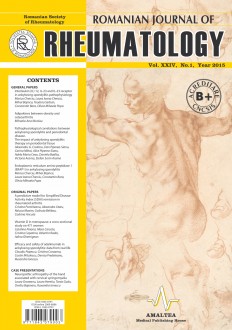SELECT ISSUE

Indexed

| |

|
|
|
| |
|
|
|

|
|
|
|
|
|
| |
|
|
HIGHLIGHTS
National Awards “Science and Research”
NEW! RJR has announced the annually National Award for "Science and Research" for the best scientific articles published throughout the year in the official journal.
Read the Recommendations for the Conduct, Reporting, Editing, and Publication of Scholarly work in Medical Journals.
The published medical research literature is a global public good. Medical journal editors have a social responsibility to promote global health by publishing, whenever possible, research that furthers health worldwide.
A PREDICTIVE MODEL FOR SIMPLIFIED DISEASE ACTIVITY INDEX (SDAI) REMISSION IN RHEUMATOID ARTHRITIS
Cristina Pomirleanu, Alexandra Jitaru, Raluca Maxim, Codruta Belibou and Codrina Ancuta
ABSTRACT
Objectives. To identify predictors for Simplified Disease Activity Index (SDAI) remission in patients with established rheumatoid arthritis (RA) under 12 months of anti-TNF therapy combined with synthetic disease modyfing antirheumatic drugs (sDMARD).
Methods. We performed a prospective observational study in 90 RA patients with a high active disease refractory to sDMARDs, starting anti-TNFs. Patients were assessed every 3 months based on a well-defined protocol, including individual parameters (clinical, inflammatory) and composite tools (simplified disease activity index SDAI, functional index HAQ-DI); total and IgA-isotype rheumatoid factor (RF) as well as anti-citrullinated peptide antibodies (ACPAs) were measured at baseline, 6 and 12 months. Therapeutic response was evaluated according to EULAR criteria. The primary endpoint was SDAI remission (≤ 3.3) at 12 months of treatment. Univariate and multivariate logistic regression analysis (Forward LR method) were used to assess the manner and intensity in which several parameters (demographics, disease-related, labs and medication) power SDAI remission.
Results. SDAI remission was reported in 39.7% cases. We identified nine relevant predictors for SDAI remission at 12 months of therapy by univariate analysis, including: age ≤ 50 years, disease onset ≤ 5 years, RA stages I and II, functional capacity stages I and II, HAQ-DI ≤ 2, concomitent sDMARD, baseline CRP ≤ 20 mg/l, IgA-RF ≤ 20 IU/ml and ACPAs ≤ 40 IU/ml. A mathematical model was further generated, based only on six out of nine parameters: age, disease stage, functional capacity, concomitent sDMARDs, CRP and ACPA. This model expressesa solid approximation for the analysed casess (the Hosmer-Lemeshow test λ² = 0.931, p = 0.920 ≥ 0.05, Cox and Snell R2 0.399). Finally, three significant factors were recognized (age under 50, disease stages I and II, ACPA levels ≤ 40 IU/ml), predicting SDAI remission with an overall constant precision of 83.3%. However, no significant impact on SDAI remission prediction was reported when adding other parameters to the above mentioned model.
Conclusion. SDAI remission can be predicted in established RA patients using three major predictors, including age ≤ 50 years, disease stages I and II and baseline ACPA levels ≤ 40 IU/ml.
Keywords: anti-TNF agents, established rheumatoid arthritis, predictors, remission, SDAI
